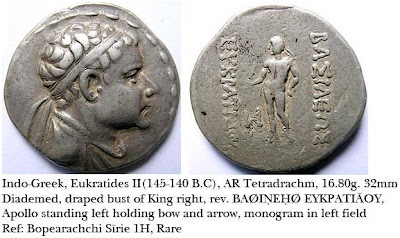GANGAS (Elephant)
 |
| GANGAS (Elephant) |
This Coin was minted during the reign of Western Gangas (5th -10th cent A.D) of Talakadu Area of Karnataka. “Bhuja in kannada” is written on the reverse.
ALUPAS (Fish)
 |
| ALUPAS (Fish) |
This Coin was minted during the reign of Alupas (4th -14th century A.D) around Barakuru, Mangaluru, Udayavara and Moodbidri
KALACHURIS (Garuda)
 |
| KALACHURIS (Garuda) |
This Coin was minted during the reign of Kalachuri's (10-12th century A.D)
RASTRAKUTAS (Lion)
 |
| RASTRAKUTAS (Lion) |
Rastrakutas (6th -10th century A.D). Coin of King Bhimadeva, 10th century A.D. Bird below the lions palm and inscription of “gandara gova” on back side.
BADAMI CHALUKYAS –Varcha (Wild Bore)
 |
| BADAMI CHALUKYAS –Varcha (Wild Bore) |
Coin of Badami Chalukyas(5-8th century A.D).
GOLD COINS OF VIJAYNAGAR KINGDOM (1336-1646 A.D)
The Gold Pagoda was the standard unit of coin issued by the Vijayanagara Empire. It was called as Pagoda in English or Varaha of 3.4 gr. The Varaha was also called the Hon, Gadyana or a Pon and came in the Ghattivaraha, Doddavaraha and Suddhavaraha coin. In the gold issue the different coins came in Varaha, this is used as a reference for the other coins values.
1 Gold Varaha = 2 Pratapas = 4 Katis = 8 Chinna = 4 Haga = 2 Bele. 1 Pana or Varana equaled 16 tara silver coin, with the 1 Tara to 3 copper Jital. The copper Duggani was equal to 2 copper kani or kakin, 5 Kasu and 10 Ara Kasu. There were also other units of silver and copper based on their relationship with the Pagoda.
 |
| Bala Krishna |
This Coin was minted during reign of King Krishnadevaraya (1509-1530 A.D)
 |
| Ram Sita |
This Gold coin was minted by King Ramachandra in 1422A.D.
 |
| Venkateswara |
This Gold coin was minted by King Srirangaraya-III (1642-1685 A.D)
 |
| Vishnu Laxmi |
This Coin was minted during the reign of King Devaraya-I (1406-1422)
 |
| Warrior |
This Gold coin was minted during King Harihara-I (1336-1354 A.D) , King Bukka-I (1354-1377 A.D) and King Harihara-II (1377-1404 A.D)
 |
| Shiv Parvati |
This Coin was minted during the reign of King Krishnaraya woodyar-III of Mysore(1799-1868 A.D)






























